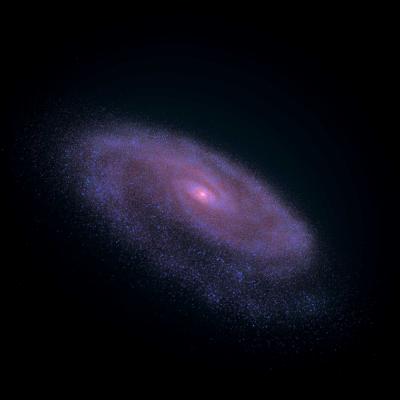The Milky Way has been around a long, long time. The age of our galaxy is approximately 13.6 billion years, give or take 800 million years. But how did the galaxy get here? What did baby photos of the Milky Way look like?
First off, there weren’t always stars in the Universe, and the Milky Way hasn’t been around forever. After the big bang happened, and the Universe cooled for a bit, all there was was gas uniformly spread throughout. Small irregularities allowed the gas to coalesce into larger and larger enough clumps, heating up and eventually starting the nuclear fusion that powers stars. The stars started to gravitationally attract each other into larger groups. The oldest of these groups of stars are called globular clusters, and some of these clusters in the Milky Way galaxy date back to the very, very early Universe.
Not all of the stars in the Milky Way date back to the primordial Universe, though. The Milky Way produces more than 7 stars per year, but it acquired much of its mass in another fashion. The Milky Way is often referred to as a “cannibal” galaxy, because during formation it swallowed up smaller galaxies. Astronomers think that this is how many larger galaxies have come to be the size they are today.
In fact, the Milky Way is currently gobbling up another galaxy, (and a stellar cluster) at this very moment. Called the Canis Major Dwarf Galaxy, the remnant stars are 45,000 light years from the galactic center, and a mere 25,000 light years from our Sun.
Older stars in the Milky Way are to be found distributed spherically in the galactic halo, meaning that it’s likely the galaxy had a spherical shape to start out. Younger stars in the galaxy are located in the disk, evidence that as it started to get heavier, the mutual orbit of material started the galaxy spinning, which resulted in the spiral one sees in representations of the Milky Way.
To get you started on how the formation of our galaxy looked, here’s an animated simulation of what a galaxy much like the Milky Way looks like as it goes from the gas cloud at the beginning of the Universe to a beautiful barred spiral, a few billion years condensed into a couple of short minutes. And to get a handle on the formation of a spiral arms in a galaxy, check out this spiral galaxy simulator.
For more on the formation of the Milky Way and other galaxies, listen to Astronomy Cast, Episode 25: The Story of Galaxy Evolution, and Episode 99: The Milky Way.
References:
http://www.nasa.gov/centers/goddard/news/topstory/2006/milkyway_seven.html
http://www.eso.org/public/news/eso0425/

